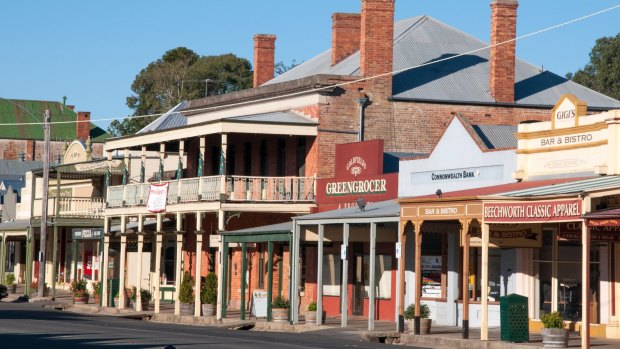Opinion
These greying country towns are the canary in the coal mine for the aged-care crisis
Shane Wright
Senior economics correspondentIncreasingly, a demographic tsunami is threatening the very existence of rural and regional communities across this wide brown land. And despite protests from our politicians, none have come up with a solution to this growing grey challenge.
Every year, the Australian Bureau of Statistics releases figures showing the age profile of communities, suburbs, towns and rural areas across the country. In its most recent report, released last week, the dire reality of how old our rural communities have become over a relatively short period was laid bare.

The median age of residents in the Victorian town of Beechworth has climbed over 50 years. It is one of many inland country towns where the population is greying.Credit: Philip Game / Alamy Stock Photo
While the report showed the single largest proportion of Australians aged over 85 live in Sydney’s Castle Hill, where six independent living villages and five for assisted living are located, get beyond the suburbs of our capital cities, and the rapid ageing problem becomes apparent.
In 2001, the Victorian town of Benalla had a total population of 10,247 residents. Of those, 2928 were under the age of 20 and 256 were at least 85. In 2023, however, the number of residents aged at least 85 had climbed to 502, while the number under 20 had fallen to just 2100 – less than 20 per cent of the population. Benalla’s median age is now a touch over 51 years.
In the NSW town of Glen Innes, a similar story is playing out. In 2001, almost 2400 of its 8848 then residents were under the age of 20, while just 171 were at least 85. By last year, the town’s total population had grown slightly to 8989, but the number of young people had fallen to 1908, and those aged over 85 now number 309.
I was born in a rural community, and spent most of my teens and early 20s living in inland country towns. The median age in one of them – Cootamundra in southern NSW, where I lived as a teenager – is now 52; two others are about 51; and another two are in their 40s. The only towns where the median age is still under 40 are where there are large populations of school or university students such as Bathurst and Albury.
Across the country, one in 10 communities now have a median age of at least 50. They stretch from Beechworth in Victoria to Dorrigo in NSW, and Gingin just north of Perth.
About a quarter of capital city residents are aged 55 or older. In regional Australia, it’s more than a third.
Since the turn of the century, the number of people under the age of 20 has climbed by about 19 per cent – from 242,000 to 1.5 million. But the number of people 85 or older has more than doubled, from 263,442 to 560,905.
The reason for all these numbers is not to complain that there are more older Australians. It should be celebrated as a policy success that if you happen to live in Australia your chances of a long life are much better than if you were born in just about any other country on the planet.
But catering for the specific needs of older Australians living regionally is going to become extremely difficult for small communities that are already struggling to provide the services, and tough choices will have to be made. For instance, does a town have to decide between maintaining a local school or putting resources towards specialist health or aged care facilities?
Australia has about 2500 retirement villages accommodating about 250,000 residents. Many more will have to be built, and staffed. There are millions more people at home who need extra assistance so they are safe and in good health. They will need carers to check in on them and carry out duties around the house.
The Retirement Living Council estimates the number of people over the age of 75 will climb from about 2 million to 3.7 million by 2040. They will have to live somewhere, and will need support staff to help them.
We hear political leaders talk incessantly about providing jobs “in the bush”. They are almost always promised in the context of a new industry, a new mine or some sort of technological breakthrough. None of them are prepared to talk about how to provide the jobs that will be necessary to care for the ageing residents of the bush.
About 70 per cent of all Australians live in capital cities. Add in other major centres such as Newcastle, Wollongong, Geelong and the Gold Coast and the proportion in “urban” Australia quickly passes 80 per cent.
The “other” 20 per cent, those living in our country towns and communities, already have – on average – lower incomes, shorter lives and more health problems than their city cousins. Leaving them to deal with rapidly ageing populations will only exacerbate the divide between the city and the bush and the growing isolation of our nation’s greying towns.
Shane Wright is a senior economics correspondent.
The Opinion newsletter is a weekly wrap of views that will challenge, champion and inform your own. Sign up here.